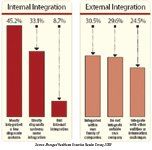State of the Industry 2009: IT system integration
Organizations should realize the need for integrating structured IT information and unstructured information, experts say, since the amount of valuable unstructured information is growing exponentially.
Healthcare delivery remains somewhat "IT-challenged," relative to industries such as banking, retail and communications. But with more than half of respondents saying they are fully or mostly integrated internally (53.9%) and externally (55%, either with outside entities or among their own family of companies), the question becomes: Is the glass half full or half empty?
While some may conclude that the integration glass is half full, organizations need to realize the need for integrating structured information and unstructured information, experts say.

Mark Frisse, MD, director of the Regional Informatics programs at the Vanderbilt Center for Better Health, is also disappointed with the overall results.
"Although I can understand the complexity of these systems-particularly with changing reimbursement rules and the slow path of software integration-as a consumer, I would like to be reassured that plans with my funds are taking every effort to devote as much of these funds as possible to improving the quality of healthcare delivery and not on compensating for administrative inefficiencies," he says. "Employers and individuals should rightly ask, 'If you don't even have your own houses in order and running efficiently, why should I allow you stewardship over my healthcare dollars?'"
Dr. Frisse believes organizations must at least achieve the essential integration of their medical systems with their pharmacy systems. On the bright side, he does expect to see some integration improvement over the next five years or so, particularly in internal consolidation, but the improvement will depend on the extent to which healthcare firms are merging.
"Also, I do not know if the external systems will be personal health records, regional health information organizations, or other sources, but I do know that health plans' [data] will be only part of a broader set of information required to improve healthcare and measure quality," he says. "That should result in a more focused set of relationships that allow individuals and their families to be empowered to participate more actively [in their own health]."
Dr. Schmuland says in the next five to 10 years, the challenge will be less about integrating existing systems and more about digitizing and improving the collaborative interactions among employees, consumers, providers, information, and processes that can improve health while reducing the per-capita cost of healthcare.
"This won't be easy and will require a new generation of commodity, Internet-based technologies that make it easier and more natural for people and teams to communicate, share insights, and work together across the workplace, the home, and multiple company boundaries," he says. "And, of course, these new technologies will need to be integrated with existing core systems, service channels, and partners."
Organizations that move beyond core system integration will be poised to take share by virtue of having flexibility to exploit new opportunities and adapt to complex and changing business demands.
In the Scope of Virtual Health and the Future of “Website” Manner, Per Ateev Mehrotra
August 10th 2023Briana Contreras, an editor of Managed Healthcare Executive, had the pleasure of catching up with MHE Editorial Advisory Board Member, Ateev Mehrotra, MD, MPH, who is a professor of healthcare policy at Harvard Medical School and an Associate Professor of Medicine and Hospitalist at Beth Israel Deaconess Medical Center.
Listen